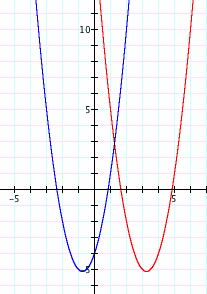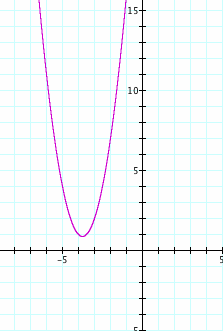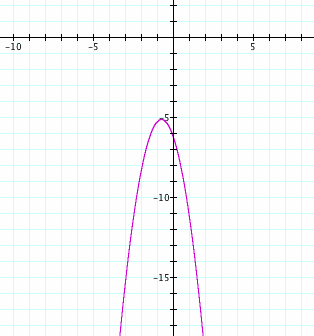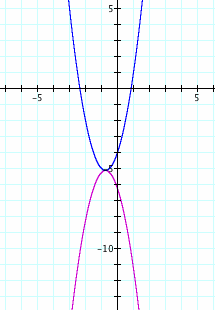

Assignment 2 Write-up
Chelsea Henderson
4. Graph the parabola ![]()
i. Overlay a new graph replacing each x by (x - 4).
ii. Change the equation to move the vertex of the graph into the second quadrant.
iii. Change the equation to produce a graph concave down that shares the same vertex.
iv. Generalize . . .
First, we graph the original parabola.
![]()

i. Overlay a new graph replacing each x by (x - 4).
We can shift the parabola over to the right 4 units by replacing each x by (x-4).
![]()
Below we see the original parabola in blue and the shifted parabola in red.

What will happen if we replace each x in the original equation by (x+4)?
ii. Change the equation to move the vertex of the graph into the second quadrant.
We can change the equation further to place the parabola in certain quadrants.
To move the parabola into the second quadrant, we would want to move the parabola to the left and up.
To move the parabola to the left, we can replace x in the original equation with (x+3). This will shift the parabola 3 units to the left.
We can move the parabola up by adding a constant to the end of the parabola. If we change the constant on the end of the equation from -4 to a positive 2, we will achieve our goal of getting the parabola into the second quadrant.
Our new equation is ![]()
This new equation produces the following graph

iii. Change the equation to produce a graph concave down that shares the same vertex.
If we want to make a parabola that is concave down and shares the same vertex as our original parabola, we will need first to find the vertex of the parabola. There are multiple ways to find this vertex. Here are two methods.
Method 1: Completing the Square
We begin with the original equation, ![]() .
.
We want to complete the square of this equation to get a standard form of a parabola, y = a(x-h)^2 + k.

Now that we have completed the square, we see that the vertex is (-3/4, -41/8).
Method 2: Using ax^2+bx+c=y formulas.
From our original equation, ![]() , we have a = 2, b= 3, and c = -4.
, we have a = 2, b= 3, and c = -4.
There ia known formula for the x-coordinate of the vertex, h, that is h=-b/2a.
Here that would be:

To find the y-coordinate of the vertex, k, we plug in our found h value into the original equation.

Again, we find the vertex is (-3/4, -41/8).
Now, we need an equation with the same vertex as our original equation, but that will produce a parabola that is concave down.
To make a parabola concave down, the sign in front of the x^2 needs to be negative.
The standard form equation that we found using Method 1 will give us what we want if we simply change the 2 in front to a negative 2.

The equation above gives the following graph:

Both the orginal equation and the concave down equation are seen on the same plot below.

What have we learned from all of this?
Above we have seen that a graph can be shifted to the left, to the right, up, and down and that a graph can be turned upside down, or reflected.
To shift a graph to the left or to the right a units (horizontal shift):
To shift to the left, replace x with (x+a);
![]()
To shift to the right, replace x with (x-a):
![]()
To shift a graph up or down a units (vertical shift):
To shift up, add the constant a to the equation:
![]()
To shift down, subtract the constant a from the equation:
![]()
To turn the graph upside down:
To flip the graph, put the equation in standard form and negate the constant in front of the x^2:

Return Home